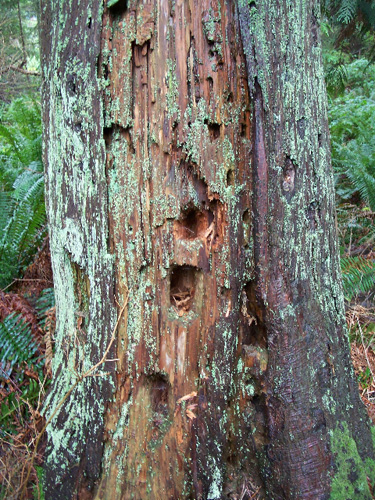Wildlife trees are one of the most valuable ecological components of forested areas. Did you know that wildlife trees provide feeding, nesting, denning, and shelter habitat for 80 species of birds, mammals and amphibians in BC? Often after hard winters of snow and high winds, treetops have broken off, branches have been lost and because of their broken down appearance these trees are viewed as only good for firewood.
What is a wildlife tree? A wildlife tree is any standing dead or live tree that provide habitat for enhancement or conservation of wildlife. Many different factors come into play to create wildlife trees. These factors include: fire, insects, fungi, human disturbance, weather, wind, disease and floods.
The large old growth trees used by open nesters; eagles, ospreys, cooper’s hawks and the larger owls are excellent candidates, as they usually remain standing for long periods of time. Each stage of the decay process has particular value to certain wildlife species. The tree can be a host to many species following its process of decay, as death and decay do not happen rapidly. Wildlife trees are not evenly distributed throughout the forest as the conditions that created them vary.
When limbs fall off trees a natural cavity like a wound becomes an entry point for weather, fungus, insects, and is attractive to chickadees, bats, owls and raccoons. Fire or decay hollow out the heartwood of western red cedars leaving a chimney effect attractive to bears as winter dens and bats as maternity denning sites.
Spike-top trees create a high vantage point and are favorite perching sites for birds of prey such as hawks and eagles. The Great Blue Heron looks for the wide branching limbs of black cottonwoods or other stands of conifers and hardwoods.
 Woodpeckers are primary cavity excavators and prefer hardwoods as a nest site. They have strong bills to chisel through the sapwood of live and dead trees. Tree swallows will only nest in a wildlife tree if a natural cavity is present or a woodpecker has provided a hole. Yellow-bellied sapsuckers drill hundreds of holes in horizontal lines to collect sap and trap insects. Early in the spring before many of the wildflowers bloom Rufus hummingbirds fill up on sap by visiting the holes drilled by the sapsucker.
Woodpeckers are primary cavity excavators and prefer hardwoods as a nest site. They have strong bills to chisel through the sapwood of live and dead trees. Tree swallows will only nest in a wildlife tree if a natural cavity is present or a woodpecker has provided a hole. Yellow-bellied sapsuckers drill hundreds of holes in horizontal lines to collect sap and trap insects. Early in the spring before many of the wildflowers bloom Rufus hummingbirds fill up on sap by visiting the holes drilled by the sapsucker.
Secondary cavity users such as small owls, some bats, raccoons, squirrels, marten and a variety of ducks take advantage of old woodpecker holes for nesting, roosting or denning. The saw-whet owl is dependent on large cavity excavators like the flicker to create a hole for it to nest in. Loose bark of the grand fir is a favorite spot for bats to roost under. Brown creepers, a small forest bird make hammock shaped nests under loose bark. Mourning cloak butterflies overwinter under loose bark. Many other insects live in dead or dying trees and are a food source for a variety of species.
Wood ducks also look for large cavities in wildlife trees especially if it is near water. Raccoons and the red squirrel are the mammals that take up residence in wildlife trees. Salamanders, an important food source for a variety of species, depend on the moist, woody trees and fallen woody debris for food and shelter. The licorice fern and red huckleberry along with many fungi and lichens thrive on wildlife trees.
[imageeffect type=”lightbox” align=”alignright” width=”250″ height=”300″ alt=”” url=”/wordpress/wp-content/uploads/2011/12/wildlife-trees-4.jpg” titleoverlay=”yes”]Our culture values images of vigor, strength and health. Death and decay are often things to be cleaned up. As spring approaches and we move outside to clean up our properties take a look around. Do you have a wildlife tree that is not a hazard to life or limb that could be left standing in your yard?
CONSULT A CERTIFIED WILDLIFE/DANGER TREE ASSESSOR FOR A DETAILED SAFETY ASSESSMENT if in doubt about a tree on your property.
You will be rewarded by the many species that come to call and liking what they find, perhaps make this tree their home.
GROWLS WEBSITE www.growls.ca for all things wild
